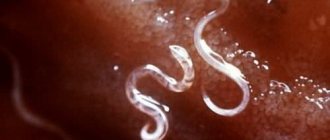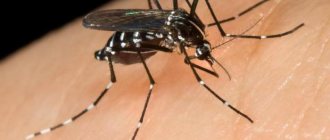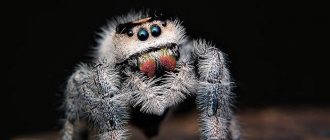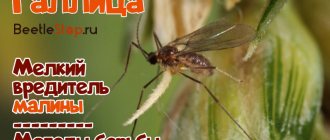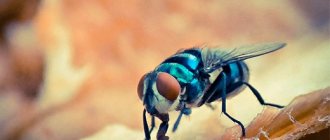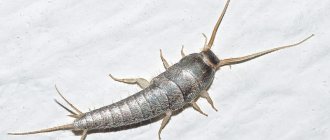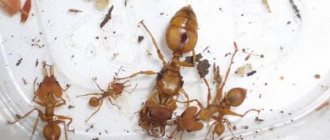A centipede is a representative of arthropods that belongs to the order Centipedes. Moreover, it is not an insect, as many people think, but an invertebrate animal! Centipedes live in almost all corners of the planet and number about 12 thousand species. In Russia you can most often find the common flycatcher. This is a small centipede with a body size of 3-5 centimeters and many thin long limbs. An adult has 15 pairs, with the last one being the largest. There are also long antennae on the head. Therefore, it is not always possible to determine where the head is and where the back of the body is.
A centipede in the house is not such a rare occurrence. It can start both in a private house and in an apartment. The publication will tell you why this happens and how to deal with it.
Reasons for appearing in the house
Knowing their habits and behavior will help you understand why there are centipedes in the house. In nature, these creatures live in damp places where there is an abundance of small insects - the main food of centipedes. With the arrival of winter, they begin to seek shelter from the cold and often wander into basements and people's homes. Flycatchers are even able to reach high floors through ventilation shafts and cracks in ceilings.
These animals are especially attracted to bathrooms, places under sinks and dark corners where spiders, cockroaches, ants and other small insects most often live. If there is a constant source of food and moisture, the flycatcher will live in the house for a long time and will even be able to reproduce successfully if other individuals are present.
That is, several factors contribute to the appearance of centipedes in the house.
- High humidity.
- Warm.
- Presence of insects.
- Darkness.
Is a centipede in the house dangerous for humans?
In general, centipedes are quite harmless creatures. They do not damage furniture, do not harm plants, and never attack people first. On the contrary, the flycatcher tries to hide back into the crack so as not to be touched. Only in rare cases, when she is in real danger, can she bite, injecting poison into the skin. But don't be afraid, he is very weak. Therefore, only slight redness occurs at the site of the bite. And then, the centipede is capable of biting through the skin of a small child and small pets. An adult is “too tough for her.”
That is, the question of whether centipedes are dangerous in the house can be answered in the negative. They do not pose a threat, but only scare away with their terrifying appearance. And so, living together with a flycatcher is very useful. She, being a predator, perfectly exterminates spiders, flies, midges, cockroaches, fleas, moths, silverfish, larvae and worms.
But not every owner, for various reasons, is able to come to terms with the fact that such a creature has appeared in his house. Therefore, people have come up with several ways to kill centipedes.
Appearance
The best description for a centipede is that it is an insect with many legs.
Because of this feature, they are difficult to confuse with other creatures. However, they do not have forty legs, as one might think from the name, but fewer. Adults have 15 pairs. Newborns have 4, with each subsequent molt the number of legs increases. The limbs are long, the further they are located from the head of the centipede, the larger they are. During movement, the legs lift the body and provide high speed, up to 40 cm per second. Adults reach a length of 35 to 60 mm. The color of the centipede is mostly gray. But yellow, brown and pink shades are possible. There are three darker bluish or reddish stripes along the body.
Millipedes belong to the order of arthropods, their body is covered with a chitinous membrane and is divided into segments. Good vision, provided by developed compound eyes, and speed of movement made centipedes excellent hunters. Their prey is cockroaches, fleas, moths, but most often flies, hence the second name of the centipede - house flytrap. Having noticed the victim, it attacks and injects a toxic substance, after which it eats the immobilized insect.
Since centipedes reproduce quickly, you need to start fighting them as early as possible. At one time, the female lays from 60 to 150 eggs; for the first two weeks after the birth of the offspring, she takes care of her offspring.
How to get rid of centipedes in the house?
The first thing that comes to mind when you see such a “miracle” in your home is to slap it with the first object you come across. Most often this becomes a slipper. But it is worth considering that the centipede is capable of restoring and regrow damaged parts of the body if it is not completely killed. It would be much more humane to catch a flycatcher in a jar and release it outside when it gets warmer.
This method is suitable if one or a pair of centipedes accidentally appeared in the house. If they have occupied the home thoroughly, then it is better to resort to more radical methods. Moreover, it is not necessary to use special drugs or toxic substances. Folk remedies are no less effective.
Eliminate moisture
The main reason why centipedes appear in the house is the abundance of moisture. Once you get rid of it, the flycatchers will leave to look for a more suitable place to live. Therefore, it is necessary to carry out general cleaning and carefully inspect hard-to-reach places (behind the bathtub, toilet and under sinks). There may be water accumulating somewhere or a wet rag lying around. All wet areas should be wiped dry. Do not allow condensation to form on pipes or walls. This can often be observed after bath procedures. You should ventilate the bathroom and wipe the floor more often. If necessary, you can use a heater to dry the air. Wet towels and floor rags must not be left in the house. It is better to dry them outside or on an open balcony. It is also worth taking a closer look at the condition of the basement and attic. If water accumulation is found there, you will have to call a plumber.
Features of centipedes
Before talking about methods of getting rid of an insect, you should find out what the pest looks like and what its characteristics are. The fact is that some representatives of the insect world are very similar to each other, because of this there is a problem with selecting the right product.
The centipede should be classified as a “labipod”. As for the length of the body, it is three centimeters. This is quite a lot for an insect that invades people's apartments and lives there.
The main feature of the centipede is its rapid movement due to the huge number of legs. Because of this, problems arise with removing the pest from the apartment. As for the living itself, the centipede likes to live in bathrooms and kitchens, where there is a damp environment and a small amount of light.
As a rule, the pest comes in the autumn, when it is quite cold outside. If you fail to breed a centipede in a short time, a lot of problems will arise. The fact is that these representatives can live more than 5 years. During that time you can get a lot of larvae.
Nutrition
During its entire existence, the centipede has no problems finding food. These could be spiders, cockroaches, termites, and so on. Before eating, the centipede injects a potent poison into the body of its victim. It kills almost instantly. Afterwards, the insect begins its meal.
From this context, we can conclude that in some cases the centipede is useful. Due to it, there will never be arachnids and other insects in your home. But the appearance really frightens the residents; they want to get rid of the pest as quickly as possible.
Benefits and harms
If there is a centipede in your house, it can cause not only harm, but also benefit. The main advantage is the eating of other insects, which you also want to get rid of. These include spiders, cockroaches, and termites.
All this is good, but many people are very afraid of the appearance of the centipede, they think that it only causes harm.
Experts note that the insect will not cause much harm to its cohabitants. It is worth remembering that if a dangerous moment arises, a centipede can release potent poison into its offender during a bite.
In appearance, the bite is very similar to a mosquito bite; severe redness and itching occurs. If you do get bitten by a centipede, it’s okay, the main thing is to immediately lubricate the affected area with iodine or hydrogen peroxide. This approach will prevent further development of redness and irritation.
If an allergic reaction occurs, take an antihistamine. Also considered a negative aspect is severe damage to plants. The fact is that the centipede simply eats them, and nothing can be done about it.
Remove the centipede's food source
Centipedes will not take up residence in a home unless there is a food source there. Therefore, your home should be checked for the presence of insects. As a rule, most centipedes will leave on their own after destroying spiders, cockroaches, flies and other living creatures. To do this, you can use various chemicals. But you shouldn’t hope that they will kill the flycatchers either. These creatures quickly develop immunity to insecticides and adapt to new conditions. Other methods will help you get rid of them completely.
Boric acid
Boric acid is considered an effective remedy for getting rid of centipedes in the house. It can be used in any form: both in powder form and in the form of an alcohol solution. If ingested or on the body, boric acid causes a severe burning sensation that usually leads to the death of the centipede.
It is enough to scatter the powder in those places where flycatchers most often appear. An alcohol solution of boric acid should be applied to walls, floors and baseboards using a spray bottle. Caution should be used when handling any form of the substance.
Preventive measures
After getting rid of centipedes, owners need to use prevention methods. Arthropods will not be able to enter the apartment if these conditions are met:
- maintain order in the local area;
- promptly clear the garden of fallen leaves and the vegetable garden of dry grass;
- clean and remove construction waste from the yard;
- remove climbing plants from external walls;
- carefully seal cracks in walls, floors, and window frames;
- strengthen small mesh on ventilation ducts;
- ventilate wet areas well;
- quickly eliminate leaks and condensation;
- fight insects that have entered your home.
It is easy to defeat this creature if you carry out preventive measures in a timely manner.
Freezing
How to get rid of centipedes in a private house in winter was known back in ancient times. For this purpose, the premises were frozen out. This is easy to do, and without any special equipment. You need to turn off all the heating in the house for 2-3 days and go live somewhere else. During this time, all pests and insects will die.
It is clear that this method is not suitable for apartments and private houses that are heated by central heating.
Modern means
Many modern people also know how to get rid of centipedes in the house. To do this, they use toxic drugs that destroy not only the flytrap, but also other uninvited guests that it attracts. Since such products belong to the category of strong chemicals, it is necessary to take safety measures. During processing, you should wear a mask and gloves, and after finishing work, ventilate the room.
The following drugs are suitable to combat flycatchers:
- "Dichlorvos Neo". Available in aerosol form, which is odorless. It kills centipedes almost instantly. The effect of the drug lasts for two weeks.
- "Raid". Also presented in the form of a spray, but with the scent of lavender. Continues to work for several days after treating the room. The product must be ventilated.
- "Medilis-Ziper". This is a rather toxic product that needs to be sprayed on the intended habitat of centipedes. The drug stands out from the rest because it does not harm pets.
- "Clean house". This product is more suitable for destroying centipede nests. But it also effectively copes with other pests.
- "Global". It is a toxic paste for killing various pests. It must be applied to arthropod habitats and around the perimeter of the room. The smell of the paste is unpleasant, but weak.
External signs of a centipede
Another name is flycatcher, scolopendra. Color yellow with black stripes. The body is oblong (reaches 3 cm), flattened and segmented. An insect has 15-20 pairs of legs; if each leg is lost or damaged, a new one grows in place. To be able to hold the victim, pincers are provided on the front two legs.
Centipedes are absolutely harmless and even useful, but they invariably cause hostility in humans
When bitten by a person, no negative effects are noted, except for minor pain. The poison through which the centipede affects its prey is dangerous only for insects (flies, cockroaches), snails, and slugs. The flycatcher has excellent vision, which allows it to move unhindered not only during the day, but also at night. The movement speed develops up to 40 cm/s. Villi are distributed on the surface of the body.
They are quite harmless. They are not dangerous to people, do not damage furniture, and do not harm plants.
The average life expectancy is 7 years, due to the ability to restore lost limbs. As a result, the speed of movement of insects does not decrease, and they can avoid dangers. Favorite habitats are where the humidity level is high. This means that centipedes are more often noticed in the bathroom, toilet, and basement. Thanks to the flattened shape of their bodies, centipedes are able to penetrate into the smallest crevices.
Prevention measures
To prevent the appearance of centipedes in a private house and apartment, it is necessary to take preventive measures. If this is not done, the flytrap may return again. What actions should be taken?
- Clean the house regularly and keep it clean. Including checking hard-to-reach places for moisture.
- Destroy small insects that may attract the centipede.
- If necessary, make cosmetic repairs (seal all cracks and holes).
- Periodically, you can treat the premises with special products against insects and other pests.
The publication told how to get rid of centipedes in a private house and apartment, as well as the reasons for their appearance. If you follow the above recommendations, these creatures will leave your home forever and never return.
Why do insects appear?
To find out how to get rid of centipedes, you need to understand that the owner of the house is to blame for their appearance, creating favorable conditions for their living. The centipede loves dampness and insects. Crawling home from the street, she looks for food - flies, various beetles, cockroaches. And if he finds her, he stays in this house for a long time. Therefore, the fight against an uninvited guest should begin with the destruction of other insects.
We recommend that you read
A private home is an ideal place for centipedes. During the day, you can hide in the basement, where there is usually increased dampness. At night, no one stops the insect from crawling across the entire area of a person’s home. As soon as the flycatcher sees a food insect, it overtakes it. Her movement speed easily allows her to do this. A centipede can catch more than one bug at a time. During lunch, she holds the other one in her paws.
Not only the basement is a refuge for the centipede. The bathroom is also suitable for her to live in, as there is high humidity. And if there are also pipes leaking in it, and there are dark corners, then the conditions for the insect are simply ideal.
In houses with old natural wood floors, centipedes live in their cracks. But she is afraid of those coatings that are treated with mastic.
Dirty dishes that are constantly left in the kitchen are often attacked by ants and midges. And the flycatcher loves these waste eaters. Therefore, there is a lot of food for her here.

